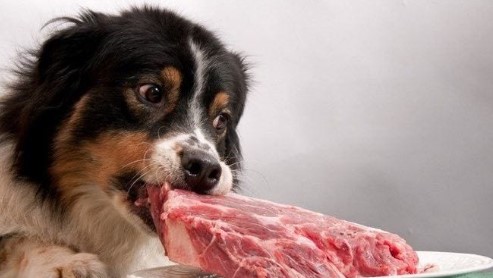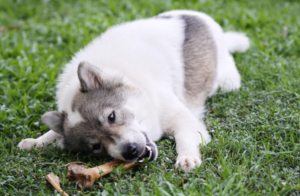
Dogs can eat steak in moderation, but it must be cooked steak. Steak is a staple meal in many households, and the smell alone is enough to get dogs drooling in anticipation. As a dog owner, you’ve probably noticed your furry friend stare longingly at you when you sit down to enjoy a juicy steak dinner.
However, some risks of feeding steak to dogs warrant consideration. However, steak can also provide nutritional benefits to dogs when incorporated responsibly into their diet.
Nutritional Value of Steak for Dogs
Steak is a good source of protein for dogs. Protein is essential for building strong muscles and keeping your dog’s cells healthy. Beef is one of the best protein sources for dogs, containing all 10 essential amino acids. The fat content in steak can also provide concentrated energy.
Steak contains vitamins and minerals that dogs need in their diet:
- Iron: Supports oxygen flow through the bloodstream.
- Zinc: Important for immune health and wound healing.
- Selenium: Helps maintain thyroid health.
- B Vitamins: Aid dogs’ metabolism and energy levels.
So nutritionally, steak can be a healthy component of a balanced dog diet. The key is moderation, as with any human food given to dogs.
Can Dogs Eat Steak?
Dogs can eat steak in moderation. Steak offers nutritional benefits to dogs, such as protein, iron, zinc, selenium, and B vitamins. These support muscle growth, immune health, metabolism, and energy levels.
However, there are also risks to consider before feeding steak to dogs. The high-fat content may cause pancreatitis or other gastrointestinal issues in some dogs. Raw steak poses a bacterial risk, while cooked steak bones may splinter and cause choking hazards or internal punctures. Steak is also high in calories, which could lead to obesity.

With proper preparation and precautions, healthy adult dogs can enjoy infrequent small amounts of steak as an occasional treat. The key is moderation. Steak should never make up more than 10% of your dog’s diet. It’s also essential to get your veterinarian’s advice about appropriate portion sizes and frequency based on your dog’s breed, size, age, and health conditions.
Risks of Feeding Steak to Dogs
While steak offers nutritional benefits, there are some risks to be aware of:
Choking Hazard: Steak has a chewy, stringy texture that could pose a choking risk, especially for smaller dogs or aggressive chewers. Cut steak into bite-sized pieces before feeding to reduce this risk.
Pancreatitis: The high-fat content of steak could trigger pancreatitis in some dogs. That is inflammation of the pancreas that can cause vomiting, diarrhea, dehydration, and other serious effects. Dogs prone to pancreatitis should only have small amounts of steak fat trimmed off.
GI Upset: Rich, fatty foods like steak may cause stomach upset, gas, or diarrhea in some dogs. Introduce small pieces slowly.
Raw Meat Danger: Raw or undercooked steak risks foodborne illness. Bacteria like E. coli and Salmonella could make your dog sick. Cook steak thoroughly to an internal temperature of at least 145°F to kill harmful bacteria.
Bone Splinters: Bones can splinter and pose a choking hazard or internal puncture risk. Never feed your dog cooked steak bones.
High Calories: Steak is high in calories, which could lead to weight gain in dogs prone to obesity. Talk to your vet about appropriate portion sizes if your dog needs to lose weight.
As long as you keep these risks in mind, steak can be part of a healthy diet for dogs in moderation. Follow the feeding guidelines below for safety.
Feeding Guidelines for Giving Steak to Dogs
Here are some tips for safely incorporating steak into your dog’s diet:
- Choose lean cuts of steak and trim off visible fat before cooking to reduce the pancreatitis risk. Top round, sirloin, or flank steak are good options.
- Cut steak into small, bite-sized pieces that won’t pose a choking hazard.
- Cook steak thoroughly to an internal temperature of at least 145°F to kill harmful bacteria. No rare steak for dogs!
- Feed plain steak without seasonings, marinades, or sauces, as these can upset your dog’s stomach.
- Start with small portions of 1-2 ounces for small dogs or 2-4 ounces for large dogs. Gradually increase portion sizes if there is no GI upset.
- Limit steak to 10% of your dog’s total daily calories. Too much can lead to pancreatitis or obesity.
- Always supervise your dog when feeding steak or human food to prevent choking.
- Talk to your vet about appropriate steak portion sizes and frequency based on your dog’s health, weight, and breed.
Can a 4 Month Old Puppy Eat Steak?
At 4 months old, puppies should not yet be fed steak. A puppy’s digestive system is still maturing and cannot correctly handle rich, fatty meats like steak at this young age.
Puppies have lower levels of digestive enzymes needed to break down heavy proteins and fats. Eating steak could lead to gastrointestinal upset like vomiting, diarrhea, or abdominal pain. Steak’s high iron and mineral content could also negatively impact bone development in growing puppies.

For the first 6 months, puppies should stick to specially formulated puppy foods designed for their nutritional needs. After 6 months, steak can be slowly introduced in small amounts if the puppy tolerates it well. Wait until 12 months to feed larger portions.
When to Avoid Giving Steak to Dogs
Certain dogs should not eat steak because of the risks:
- Puppies: Their digestive systems can’t handle rich meat yet. Wait until your pup is at least 6 months old.
- Seniors: Older dogs may have trouble digesting fat and have a higher pancreatitis risk.
- Overweight/obese dogs: Steak is high-calorie and could lead to further weight gain. Stick to dog food until weight normalizes.
- Dogs with chronic GI issues: The fat may exacerbate diarrhea, vomiting, and stomach inflammation.
- Dogs with liver or kidney disease: Their bodies can’t process high protein efficiently. Avoid steak.
- Dogs with a history of pancreatitis: The fat content can trigger another painful flare-up.
If your dog falls into any of these categories, avoid steak. Check with your vet about any people’s food restrictions related to your dog’s health conditions.
Signs of Illness in Dogs After Eating Steak
Monitor your dog closely after first introducing steak to watch for the following signs of illness:
- Excessive vomiting or diarrhea
- Lethargy, weakness, or loss of coordination
- Abdominal pain or bloating
- Dehydration – dry gums, rapid heart rate
- Increased thirst or no appetite
- Yellowing of gums, skin, or eyes
Stop giving steak and call your vet immediately if you notice any concerning symptoms after feeding it to your dog. Catching issues early dramatically improves the chance of recovery.
FAQs on Can Dogs Eat Steak
Can puppies eat steak?
No, puppies should not eat steak. Their digestive systems are immature enough to handle rich, fatty meats like steak. Before introducing small amounts of cooked steak, wait until your puppy is at least 6 months old.
Is it okay to give my dog raw steak?
No, dogs should never eat raw or undercooked steak as it poses a high risk of foodborne illness from bacteria like Salmonella or E. coli. Always cook steak thoroughly to an internal temperature of at least 145°F.
What is the best cut of steak to feed my dog?
Leaner cuts like top rounds, sirloin, or flank steak are best. They are lower in fat than fattier cuts like ribeye or T-bone, reducing the risk of pancreatitis. Avoid marbled cuts.
How much steak should I feed my dog?
Generally, steak should be no more than 10% of your dog’s total daily calories. A few ounces 1-2 times a week is sufficient for most dogs. Always consult your vet on appropriate portions based on your dog’s weight, breed size, age, and health.
Final Words
Dogs love steak as much as humans, but it does carry some health risks and should only be fed occasionally in moderation. For healthy dogs, though, a few bites of cooked, unseasoned steak make a tasty treat and a healthy addition to their diet when guidelines are followed.
Just be sure to check with your vet about the appropriate amount and frequency of steak for your dog based on health, breed size, weight, and age. With some common-sense precautions, you and your dog can safely share the occasional steak dinner.





